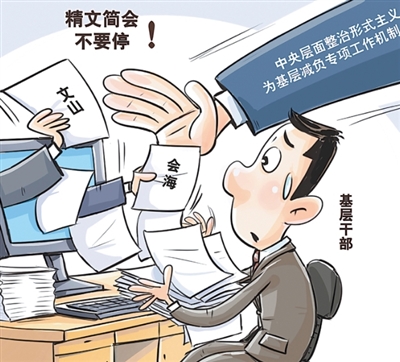Abandoning Formalism and Focusing on Implementation Measures
Since the implementation of the Central Eight-Point Guideline on improving work conduct, many regions have introduced measures to strictly control the number and duration of meetings, allowing officials to dedicate more time and effort to practical work. How are meetings conducted now? Let’s take a closer look at how this new approach has led to tangible results.
Fewer Meetings, More Field Work
At 10 a.m. on Tuesday, Huang Xin, director of the Township Construction Office in Xikou Town, Longyou County, Quzhou City, Zhejiang Province, grabbed his notebook and hurried out of his office, heading straight for Bianshi Village. In recent years, Tuesdays—designated as “No-Meeting Days”—have become Huang’s fixed time for on-site inspections.
“Summer electricity consumption has surged, and we must ensure residents’ daily lives aren’t disrupted. The capacity expansion needs urgent attention,” Huang said. After receiving feedback from villagers about the pressing need for power line upgrades, he wasted no time in visiting the site.
Accompanied by Tu Anqing, head of the Xikou Power Supply Station, Huang walked through the streets, inspecting the area and discussing implementation plans. “Old Tu, let’s ensure enough space is reserved during this upgrade,” Huang said, pointing at the blueprint. “Homestays are expanding, agricultural greenhouses need power, and charging stations must be planned ahead.”
These considerations stemmed from Huang’s frequent field visits during no-meeting days. His notebook was filled with villagers’ requests: Aunt Zhang wanted to open a farmhouse restaurant and needed a power upgrade; Uncle Wang needed a dedicated line for his fish pond’s aerator; the village planned to upgrade streetlights to solar power. “Before, meetings only discussed generalities, but on-site visits reveal the specifics,” Huang remarked.
Tu Anqing fully agreed with Huang’s approach: “By saving time and energy from meetings, we can focus on field visits. Only by being on-site can we truly identify and solve problems.”
Huang admitted, “In the past, it wasn’t that we didn’t want to visit the field, but meetings and trivial tasks made it hard to prioritize on-site work.” Now, things have changed—officials step out of their offices, turning problem sites into meeting rooms.
Quzhou pioneered the “No-Meeting Tuesday” policy in 2018, which later spread across Zhejiang. Today, streamlined meetings and field visits have become the norm.
Streamlining meetings allows officials more time to engage with communities and solve problems. In Quzhou, meeting numbers have dropped by nearly 20%, while officials now spend over half their workweek in the field. “Moving the office closer to the people is the core value of this initiative.”
Shorter Meetings, More Practical Discussions
Excessive meetings once drained grassroots energy. Recently, a concise meeting in Yangdang Town, Zaoyang City, Hubei Province, brought relief to local officials.
By 9 a.m., the meeting room was set up—minimalist and efficient. “Now, we skip flowers, backdrops, and other unnecessary decorations. It takes just minutes to prepare, saving time and money,” said Yang Bin, the town’s administrative office director.
The meeting began promptly. Liao Zhigang, the town’s Party secretary, opened: “Today, we’re combining four meetings into one—public safety, drowning prevention, mental health services, and military recruitment. Originally, 12 units were scheduled to speak, but we’ll focus on key points, limiting each speaker to three minutes.”
Zhao Wei, Party secretary of the town’s central community, spoke first. Next up, Zhou Feng from the market supervision office quickly highlighted key points in his report. As Zhao’s time ran out, Liao interjected: “Time’s up. Submit the rest in writing.”
“We’ve grown accustomed to this format,” said Qiu Chaolu, the town’s publicity officer. Since implementing the Central Eight-Point Guideline, meetings have become more efficient, with a shared emphasis on practicality.
By 10 a.m., the meeting concluded—far shorter than



